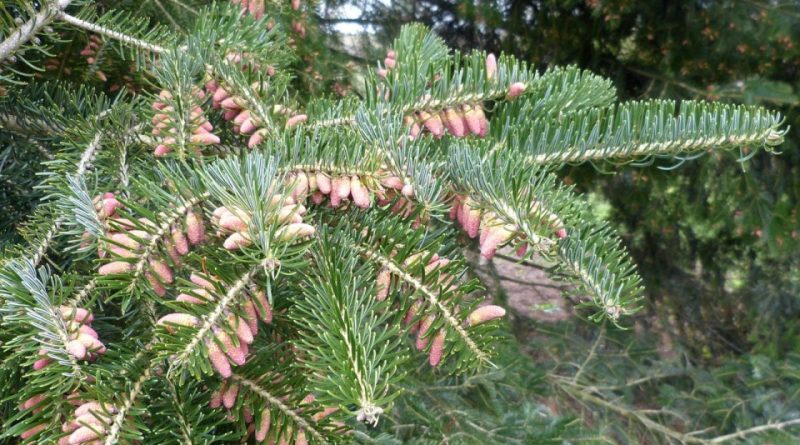Abies × borisii-regis
Abies × borisii-regis
The King Boris Fir (Abies × borisii-regis Mattf., 1925) is a conifer belonging to the Pinaceae family.
Systematics –
From a systematic point of view it belongs to:
Eukaryota Domain,
Kingdom Plantae,
Pinophyta Division,
Pinopsida class,
Order Pinales,
Pinaceae family,
Genus Abies,
Species A. × borisii-regis.
The following terms are synonymous:
– Abies cilicica subsp. borisii-regis (Mattf.) Silba;
– Abies cilicica var. borisii-regis (Mattf.) Silba.
Etymology –
The term Abies comes from Abies, a classical Latin name (Virgil, Egloghe) from the Sanskrit root abh gush, referring to the resin.
The specific epithet borisii-regis is the genitive of the Latinization of Re-Boris, dedicated to King Boris III of Bulgaria (Boris Klemens Robert Maria Pius Ludwig Stanislaus Xaver, 1894-1943) during whose reign this new species was described in 1925.
Geographic Distribution and Habitat –
The King Boris Fir is a plant that grows in the Balkan mountains, characteristic of some mountain forests in an area that includes Albania, Greece, North Macedonia and Bulgaria, where it forms pure forests or in association with Picea abies; at lower altitudes it can mix with deciduous species.
Its preferential habitat is that of areas between 700 and 1500 m, withstanding minimum temperatures of over -20 ° C.
Description –
Abies × borisii-regis is a natural hybrid between Abies alba and Abies cephalonica.
It is an evergreen conifer that can reach up to 40 meters in height, with a single rounded trunk up to 1.6 meters in diameter, with a bark that is smooth and gray when young and becomes darker and more furrowed over the years.
The crown is conical and in the older specimens it flattens on the top.
The branches of the first order branch out horizontally from the stem. The shoots are slender and flexible (those that support the cones are more rigid), of a yellow-gray color, streaked with yellow or brown pubescences.
The leaves are needles 1,5-3 cm long and 1,5-2,6 mm broad, linear and with whole tips, arranged in a spiral on two orders; they have a dark green color above, with two lighter green bands of stomata below. The gems are 6mm long and 4mm wide, resin free.
The flowers are male strobili about 20 mm long, crowded on the buds, greenish-yellow with purple or red microsporophylls.
The fruits are erect, cylindrical cones, 10-15 cm long and 3-5 cm broad, yellow-green before maturity, then brown; they have an obtuse or conical tip. The scales are cup-shaped, with smooth surface and entire external margin, 25-30 mm long and wide. The bracts are linear with a long cusp, up to 4 cm long, slightly curved. The seeds are angular, 7-9 mm long, and with a reddish-yellow winged part, 10-15 mm long.
Cultivation –
Abies borisii-regis is a fir native to the mountains of the Balkan peninsula and which grows at altitudes of 700-1,800 m, on mountains with annual rainfall exceeding 1,000 mm.
It is a large evergreen conifer that prefers areas with climatic and pedological conditions similar to its range of origin.
Customs and Traditions –
This taxon was first discovered and described in the Rhodope Mountains in Bulgaria and on Mount Olympus, having been discussed in several taxonomy treatises. Already in the early 1970s (Liu) the hypothesis was formulated that it was a natural interspecific hybrid between Abies alba and Abies cephalonica; although mainly resembling A. alba, minor characters of both species are recognizable.
Subsequent and more recent genetic researches regarding hybridization (Mitsopoulos and Panetsos, 1987), have come to the conclusion that this hybrid species is the result of a process of introgression by A. alba within ancient pre-existing populations of A. cephalonica, which occurred during the Pleistocene glaciations; this process would still be in progress suggesting the hypothesis that this hybrid species could become dominant, relegating A. cephalonica to ever more restricted and localized relict areas. For these reasons, the tendency prevails to consider Abies × borisii-regis as a unique species, albeit the result of hybridization, compared to the one that would place it on a lower level classifying it as a subspecies.
The scientific name, as mentioned, honors Tsar Boris III of Bulgaria, during whose reign it was described as a new species in 1925. The name is sometimes mentioned without a hyphen (Abies borisiiregis), albeit according to the provisions of article 60.9 of the ICBN the hyphen must be kept.
As for its uses, this species has a wood similar to that of A. alba and is used in construction especially for the construction of internal parts, such as plywood or veneers. During the nineteenth century this species was frequently planted in arboretums, showing better acclimatization in the British Isles than A. alba.
From an ecological point of view, with regard to its state of conservation, the Abies borisii-regis is not classified in the IUCN Red List.
Preparation Method –
The Abies borisii-regis is a conifer that plays an important ecological role in the areas of origin and in which it has no particular uses, neither food nor medicinal.
However, this species has a wood similar to that of A. alba which can be used in construction especially for the construction of internal parts, such as plywood or veneers.
Guido Bissanti
Sources
– Acta Plantarum – Flora of the Italian Regions.
– Wikipedia, the free encyclopedia.
– Useful Tropical Plants Database.
– Conti F., Abbate G., Alessandrini A., Blasi C. (ed.), 2005. An annotated checklist of the Italian vascular flora, Palombi Editore.
– Pignatti S., 1982. Flora of Italy, Edagricole, Bologna.
– Treben M., 2000. Health from the Lord’s Pharmacy, Advice and experiences with medicinal herbs, Ennsthaler Editore.
Photo – source: https://www.conifers.org/pi/Abies_borisii-regis.php
Warning: Pharmaceutical applications and alimurgical uses are indicated for informational purposes only, they do not represent in any way a medical prescription; therefore no responsibility is taken for their use for curative, aesthetic or food purposes.


